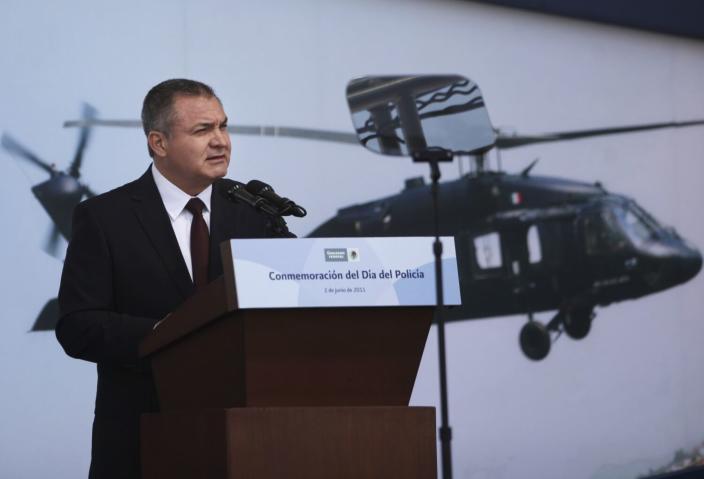Genaro García Luna is a former Mexican government official and engineer. He served as Secretary of Public Security in the federal cabinet of President Felipe Calderón Hinojosa.
As minister of public security from 2006 to 2012, García Luna is widely regarded as the architect of Calderón’s controversial war on the drug cartels.
García Luna started his career at the National Intelligence Center, Mexico’s CIA equivalent, in 1989 and joined a special counterterrorism unit. After nearly a decade, he joined the federal police, and in 2001, then-President Vicente Fox named him head of the new Federal Investigation Agency.
At the agency, known as the AFI, which has since been dissolved, García Luna led what was hailed as a transformation of Mexico’s police forces.
In a series of interviews that Correa-Cabrera had with García Luna in 2017 and 2018, he said that the federal judicial police had ties to drug trafficking and that he had been given the responsibility to clean it up.
“AFI was the promise of a better police, one not connected to drug trafficking,” she said.
The Mexican government at the time likened the new agency to the FBI. When Calderón took the presidency in 2006, he elevated García Luna to his Cabinet.

Rumors and cold trails
Soon after Fox took office in 2000, the government captured several Sinaloa cartel members. But after that initial sprint, things quieted down. Opposition politicians and security experts started to question why the government’s hunt for the elusive cartel leader El Chapo seemed to have gone cold.
Calderón’s declared war on the drug cartels shattered old alliances and drove drug lords to fight over the territory. There were high-profile arrests, but they were mostly from rival organizations such as the Zetas or the Beltrán Leyva organization. Rumors of government favoritism toward the Sinaloa cartel grew louder.
During the heat of the drug wars in 2008, Mexicans in several states woke up to banners or narcomantas hanging from bridges or spread across the entrance to a cathedral that accused García Luna of protecting drug dealers.
One of the most controversial claims appeared in a letter published in November 2012 in the pages of the well-regarded national newspaper Reforma. Writing from prison, Édgar “La Barbie” Valdez Villareal, a drug kingpin from the Beltrán Leyva cartel, accused García Luna and his closest associates of receiving narco money since 2002.
“I can attest that he has received money from me, from drug-trafficking groups and organized crime,” said Valdez, before adding, “I may be guilty of a lot, but they, the officials, are part of the criminal structure of this country.”
Officials said the accusations were an attempt by Valdez to gain privileges while in prison; García Luna remained untouched. (Valdez was sentenced in 2018 by a U.S. judge to 49 years in prison.)
García Luna’s life in Miami
When Calderón’s term ended in 2012, García Luna fell out of the public eye. Married with two children, he was granted permanent residency in the United States and was soon a routine guest at conferences hosted by American universities.
He started a private security consulting and risk management firm with offices in Miami and Mexico City. His clientele included foreign governments and companies, and his primary client was the Mexican government, his defense said in pretrial filings.
In 2018, he applied to become a naturalized U.S. citizen. Before his arrest in Miami, he was living in a waterside mansion “with a dock and boat for his use,” all given to him by his business partners because “he had no wealth to speak of at the time,” García Luna’s defense wrote in a court filing.
“Because his business partners wanted to ensure Mr. García Luna’s continued involvement with their business, they provided him a place to live in Miami,” the defense wrote.

On to Brooklyn
It seems unlikely that García Luna’s trial — which is expected to last two months — will be as theatrical as that of Guzmán, who was famous worldwide as an escape artist who had long eluded arrest.
But prosecutors have telegraphed in court filings that they expect to present numerous witnesses — including former high-ranking members of the Sinaloa cartel — to testify about the bribes García Luna is accused of accepting.
The judge granted prosecutors’ requests for an anonymous and partially sequestered jury, the same protections that were used during Guzmán’s trial.
The documents in the case are voluminous. García Luna’s public defender, assigned by the court after the defendant’s assets were seized, has complained in initial court appearances about having to go through “millions of pages” of evidence with little support.
If found guilty, García Luna could face a minimum of about 20 years in prison and a maximum of life.
Source: El Pais



